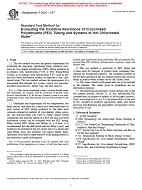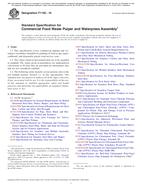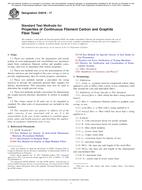1.1 This specification covers stereotactic instruments used by neurosurgeons to assist in the placement of probes, such as cannulae, needles, forceps, or electrodes or to direct radiation into brain regions or anatomical targets that are not visible on the surface. The general location of these regions is determined by measurements from landmarks visualized by X ray or other means, such measurements being based on atlases derived from anatomical studies and autopsy. Because of the anatomical variability, more precise location in any single patient may be determined by physiological responses in that patient. The degree of success in stereotactic surgery depends upon the experience of the surgeon as well as the precision of the stereotactic instrument. Nevertheless, minimum standards of accuracy for stereotactic instruments that are within the range of variability of human anatomy must be maintained.
1.2 For the purpose of this specification, a stereotactic instrument is a guiding device used in human neurosurgery for the purpose of directing an instrument or treating modality to a specific point within the brain by radiographic or other visualization of landmarks.
1.3 Stereotactic instruments must be constructed to afford the surgeon reliably reproducible accuracy in placing instruments into target areas. Proper positioning of the probe is often verified by X rays to control errors in calculation and to correct deflection of the probe during insertion. Physiological parameters may be used to further define the optimal target.
1.4 At the present time, stereotactic instruments are used most frequently, but not exclusively in the following operations. The list is presented only to present examples and should not be construed to restrict advances or developments of new procedures. For some applications it is not required to hit a point in space, but to hit a volume or make a lesion within a mass. For that purpose, devices other than those covered by this specification may be employed, but should be restricted to such uses:
1.4.1 Thalamotomy for parkinsonism and other types of tremor,
1.4.2 Electrode implantation for epilepsy,
1.4.3 Needle or magnetic insertion, or both, for aneurysm thrombosis,
1.4.4 Thalamic or subthalamic operations for dystonia,
1.4.5 Thalamic or subthalamic operations for involuntary movements such as chorea or hemiballismus,
1.4.6 Ablation of deep cerebellar nuclei for spasticity,
1.4.7 Cingulotomy and thalamic or subthalamic surgery for pain,
1.4.8 Mesencephalotomy or tractotomy for pain,
1.4.9 Ablations of subcortical temporal lobe structures for treatment of epilepsy,
1.4.10 Psychosurgical procedures,
1.4.11 Implantation of depth stimulating electrodes for pain,
1.4.12 Insertion of forceps or needle for obtaining biopsy specimens,
1.4.13 Foreign body removal,
1.4.14 Implantation of radioactive material, and
1.4.15 Biopsy or treatment of tumors.
This standard does not purport to address all of the safety concerns, if any, associated with its use. It is the responsibility of the user of this standard to establish appropriate safety and health practices and determine the applicability of regulatory limitations prior to use.
Product Details
- Published:
- 01/01/2002
- Number of Pages:
- 6
- File Size:
- 1 file , 53 KB


